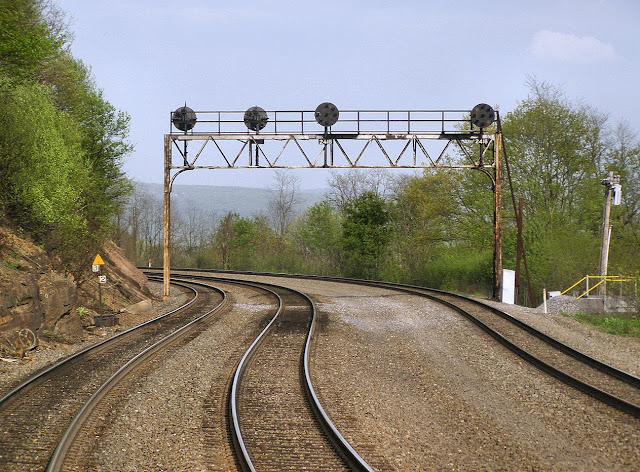The survey can be found here arranged chronologically for easy following along.
Catching the Capitol Limited in Pittsburgh is no easy feat as its scheduled departure is about 5:15 in the morning. As such I had to get up sometime around 3:30 and catch the very first morning bus that ran downtown on Forbes. Fortunately my chariot of the masses arrived and deposited me a few blocks from Penn Station with enough spare time for some photos. Here we see the west end of the Pittsburgh station platform with the old CP-WEST PITT relay box taken shortly before the Cap arrived.
The trainset for the eastbound Pennsylvanian was waiting patiently under the trainshed for its 8am departure.
Departing Pittsburgh the Capitol Limited takes the Bloom Connector to the old B&O P&W Sub, which was the original route of the B&O between Pittsburgh and New Castle. The line is overland and twisty and for many years the B&O retained traffic rights over the generally superior Pittsburgh and Lake Erie route. After CSX purchased the P&LE in the early 90's almost all of their traffic shifted to the P&LE route leaving the P&W to eventually be leased off to two short lines and the signaling removed. Anyway, even back in B&O days the road used the P&LE main line between McKeeysport and Braddock, PA and to this day the old P&LE flavor remains evident for anyone bothering to look out the back of the train.
The old P&LE route consists of four back to back interlockings the first of which is BRADDOCK where the P&W curves away from the P&LE route. The P&LE line will cross to the far bank of the Monongahela over a bridge that has always been single track as in P&LE days this was the far southern end of its route and didn't warrant a second track. Between 2003 and 2005 the interlocking was re-build to provide a straight route for trains on the P&LE while moves to/from the P&W had to diverge. Also about that time the 2-track P&W was reduced to a single bi-directional track and the nearby GLENNWOOD tower was closed.
Here my train makes the diverging movement from the single P&W track onto P&LE Track 1 at BRADDOCK interlocking. BRADDOCK is of a double ladder configuration and also note the rust on the second P&W track as it is now used to store surplus "coke express" hopper cars.
Next up in DEMMLER interlocking which provides access to the west end of Demmler Yard, which was the P&LE's main yard in this area directly serving the USS Edgar J. Thompson steel mill. This interlocking is a full crossover with yard lead and hosts a P&LE signal gantry at each end with traditional searchlight signals.
At the other end of Demmler Yard is RIVERTON interlocking with another full crossover and yard leads. It is a popular railfan spot and notable for the unique three-mast cantilever on the west end covering both main tracks and a yard lead. Unfortunately I just saw a photo indicating that the westbound mast signals are being replaced by a new cantilever despite being in very good condition. Let's hope that the rest of the searchlights at RIVERTON are not under threat of replacement.
Here my train takes a diverging route from track 1 to track 2.
You never know what is around to suddenly appear out of the fog when railfanning. Seconds after having passed the westbound signals at RIVERTON I passed a special Amtrak shop move from Bear, DE to Beech Grove, IN consisting of a P42, 5 800 series P40's and two Amfleet I's. What amazingly good luck!!
Next up is McKEEYSPORT interlocking. This was once the terminus of the short lived PATrain commuter service from the old B&O Pittsburgh Station, but today the interlocking only has a single switch on track #2 for a former P&LE branch down the Monongahela river valley. The P&LE/B&O main line hangs a left and takes off down the Youghiogheny River valley. Hang in to the end of the video because CSX recently replaced a searchlight bracket mast at the east end of the plant with brand new searchlight mast signals!!! Ugh, why can't CSX be consistent!
The next interlocking is SINNS and is the former division post between the PL&E and B&O Keystone subdivision. Until recently that meant the change from searchlights and Rule 261 to CPL's and Rule D-251. I lucked out twice on this little string of videos as first I caught the Amtrak shop move and then two interlockings later I managed to capture a CSX freight on the adjacent track with the Sinns defect detector sounding off for my own train. All in all it is one of the best videos I have ever shot at least from a compositional point of view. XD
































